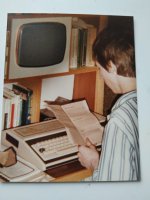robjordan
Member
My dad brought home an Exidy Sorceror in 1978 or 79, when I was 15 years old. I learned to program on that machine, later moving to BBC Micro. It was my number one hobby, but I never had a thought of making it a career until I was almost through university. Finally it dawned on me I could make a living doing what I loved. In a 35 year career I was a software developer, network specialist, technical and enterprise architect, consultant, lecturer. I had plenty of fun, but as I moved up the ladder had fewer and fewer opportunities to just play with computers, and I missed it.
I'm now fully retired, and seem to have returned to that early enthusiasm. Lately I've been learning something about electronics - which is new to me. Following I guess a typical hobbyist path of Arduino, microcontrollers, small circuit design. I still have that Sorceror. I tried firing it up a while ago and it hummed but didn't display anything. I have an ambition to see it working again. It's quite daunting and I'd love to have access to a community who might be able to help me with that task.
I'm in the UK.
Rob
I'm now fully retired, and seem to have returned to that early enthusiasm. Lately I've been learning something about electronics - which is new to me. Following I guess a typical hobbyist path of Arduino, microcontrollers, small circuit design. I still have that Sorceror. I tried firing it up a while ago and it hummed but didn't display anything. I have an ambition to see it working again. It's quite daunting and I'd love to have access to a community who might be able to help me with that task.
I'm in the UK.
Rob


